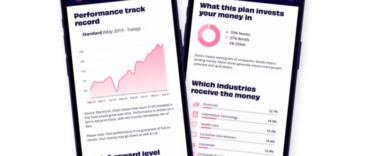
What is auto-enrolment?
Automatic enrolment, also called auto-enrolment, is when an employer puts qualifying employees into a workplace pension scheme. It is required by law and applies to all UK employers.
Under previous rules, workers would need to request to join the workplace pension after they had started at a new company. However, this opt-in system has been replaced to encourage more people to save for retirement.
Contributions will need to come directly from an employee's pay once they are part of the scheme. They can choose to opt out, but the employer must ensure that all qualifying workers are enrolled every three years. This means that staff who have previously opted out will be re-enrolled at a later date.
To be eligible, employees must be over 22 years old and be paid at least £10,000 per tax year. You can learn more about the basics of auto-enrolment in our article 'What is auto-enrolment?'.
What an employer needs to do
Different employers will have different specific responsibilities, but you can use the Pensions Regulator online tool to check what applies to your business.
There are a number of steps employers should follow and we list these below.
1.) Learn as much as you can
Auto-enrolment is an important responsibility for employers, so it is critical to learn as much as you can before your first employee walks through the door.
A good place to start is to get in contact with the Pensions Regulator. You will be sent helpful tips and important information by email to help make sure that you are fulfilling your duties within the correct time frame.
2.) Set up a workplace pension
This is a big one. You will need to pick a provider, decide what payroll software you need and make a call on how much you will be contributing to your workers’ pensions.
You will also need to decide how much of the process you want to undertake yourself and how much you want to hand over to your provider or the payroll software you are using. Payroll software can calculate contributions, communicate with employees, keep records and assess your staff. This can all be a great time-saver when it comes to managing auto-enrolment.
As this is such an important part of the process, you may want to start at least two months before your first employee arrives at your business, if possible.
3.) Find out who qualifies
The key factors when it comes to qualifying for auto-enrolment are age and pay. Employees earning £10,000 or more and aged 22-65 will qualify. You can see the relevant details in this table.
| Annual salary | Age 16 - 21 | Age 22 - 66 (State Pension age) | Age 66 (State Pension age) - 74 |
| £6,240 or less | Employee must be enrolled if they ask. No requirement for employer to contribute, but can choose to. | ||
| £6,240.01 - £9,999.99 | Employee must be enrolled if they ask. Employer required to contribute. | ||
| £10,000 and over | Employee must be enrolled if they ask. No requirement for employer to contribute, but can choose to. | Employee must be auto-enrolled and employer must contribute. | Employee must be enrolled if they ask. No requirement for employer to contribute, but can choose to. |
It is possible to put off assessing your workforce for up to three months. This could be because new starters have to pass a probationary period or you want to wait for the beginning of a new pay period. You will need to tell any staff that are impacted if you choose to postpone.
4.) Enrol qualifying staff
Once you have assessed your workforce, you need to enrol the eligible members of staff. Your chosen pension provider will have a process you need to follow in order to set your employees up with the scheme. This can be a simple process, depending on the provider you have chosen.
5.) Tell staff what is happening
Employers are required by law to write to each employee and explain how the auto-enrolment process will affect them. You should also provide details about the workplace pension scheme.
Some payroll software can produce a template letter or automated email to make this part of the process easier. You should send the correspondence within six weeks of your employer responsibilities starting.
6.) Declare your compliance with the Pensions Regulator
Within five months of your auto-enrolment responsibilities kicking in, your business will need to file a 'declaration of compliance' with the Pensions Regulator, confirming that you have completed the required steps. The form can be found on the Pensions Regulator website.
If you do not do this, or if send the form in late, your business could be fined. It is important to make sure all of the information sent is correct, as any mistakes could also lead to a fine.
Does automatic enrolment apply to your business?
If you are an employer, you have a legal responsibility to auto-enrol qualifying staff. It does not matter if you are an electrician, a technician, a beautician or an obstetrician. From the day your first employee starts work, you will need to be aware of your duties.
Because employer responsibilities kick in as soon as the first employee starts, it makes sense to get the ball rolling much earlier in order to be well prepared.
Ongoing responsibilities for employers
An employer’s auto-enrolment responsibilities do not end once a new starter is added to the pension scheme. There are ongoing obligations that must be carried out.
Employers will need to:
- Keep track of the age and earnings of all employees to see who is newly eligible to be auto-enrolled
- Every three years, check who needs to be re-enrolled and re-declare compliance with the Pensions Regulator
- Follow up on requests to opt out or opt in to the workplace pension scheme
- Make sure minimum contribution levels are being met
- Keep records of how all legal responsibilities are being met
How much does auto-enrolment cost?
Auto-enrolment involves set-up costs and ongoing costs for employers. Time and money will need to be spent on getting everything up and running, plus paying into the workplace pension and managing the system.
Here are the main costs employers should be aware of.
| Initial costs | The exact amount you pay to set up automatic enrolment for your workplace pension will depend on a whole host of factors and will vary from business to business. It is important to consider that while some providers may be more expensive than others, picking an option that does much of the work for you could prove valuable in the long run.
On the other hand, there are a lot of great free resources out there that can help you set up your scheme and understand your auto-enrolment responsibilities as an employer. |
| Time costs | The time it will take to set up a workplace pension and complete auto-enrolment is something you will need to take into account. The help available online can make the process easier, but it will still take time to fully understand the responsibilities of an employer and arrange everything correctly.
If you feel that you are not fully on top of what you need to do, the next step could be to seek professional help. |
| Paying for advice | It is not necessary to pay for extra help to set up auto-enrolment, but you may find that the right business advisor can take a lot of the strain and save you valuable time.
The final cost of any assistance will depend on whether you are looking for advice or more hands-on support. It will also depend on whether you need a financial advisor, an accountant or a payroll provider. |
| Setting up payroll | There should not be significant additional costs to setting up payroll with auto-enrolment in comparison to setting up one without. However, there is important information that will need to pass from your business’s payroll to your chosen workplace pension provider.
You may find that the additional work and time that auto-enrolment generates means that you move from doing payroll yourself to outsourcing. This will obviously bring an extra cost. |
Official guidance and support
There are a whole host of great tools and information available on the Pensions Regulator website. These can help you keep on top of your responsibilities as an employer and help you avoid the pitfalls that can lead to expensive fines.
The Pensions Regulator online tool should be the first place you visit.
Alternatively, you could choose to speak to a business advisor or accountant and pay for specialist help in setting up auto-enrolment. Specialist pension provider Penfold* is one such company that can provide help and guidance with setting up an auto-enrolment workplace pension.
If a link has an * beside it this means that it is an affiliated link. If you go via the link, Money to the Masses may receive a small fee which helps keep Money to the Masses free to use. The following link can be used if you do not wish to help Money to the Masses or take advantage of any exclusive offers - Penfold




